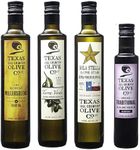Buying Guide for the Best Organic Olive Oils
Choosing the right organic olive oil can be a delightful journey into the world of flavors, health benefits, and culinary versatility. Organic olive oil is not only a staple in many kitchens but also a product that can vary greatly in taste, quality, and use. To make the best choice, it's important to understand the key specifications that differentiate one olive oil from another. Here’s a guide to help you navigate through the essential aspects of selecting the perfect organic olive oil for your needs.Type of Olive OilOlive oil comes in various types, including extra virgin, virgin, and refined. Extra virgin olive oil is the highest quality, made from pure, cold-pressed olives, and has a robust flavor and high nutritional value. Virgin olive oil is also made from pure olives but may have a slightly lower quality and milder taste. Refined olive oil is processed to remove impurities and has a more neutral flavor. If you are looking for the best flavor and health benefits, extra virgin is the way to go. For cooking at higher temperatures or a more subtle taste, virgin or refined might be more suitable.
Acidity LevelThe acidity level in olive oil is a measure of the free fatty acids present, which can affect the taste and quality. Extra virgin olive oil typically has an acidity level of less than 0.8%, indicating high quality and a fresh, fruity taste. Virgin olive oil can have up to 2% acidity, while refined olive oil has even higher levels. Lower acidity levels are generally preferred for their superior taste and health benefits. If you are using olive oil for dressings or dipping, opt for lower acidity. For cooking, higher acidity levels might be acceptable.
Flavor ProfileOlive oils can have a wide range of flavors, from fruity and grassy to peppery and bitter. The flavor profile is influenced by the type of olives used, the region where they are grown, and the production process. Fruity and grassy flavors are often preferred for salads and dipping, while peppery and bitter notes can add depth to cooked dishes. Consider what you will be using the olive oil for and choose a flavor profile that complements your culinary needs.
Harvest DateThe harvest date indicates when the olives were picked and processed. Fresher olive oil tends to have better flavor and nutritional properties. Look for oils that have a recent harvest date, ideally within the past year. Older oils may lose their flavor and health benefits over time. If you want the freshest and most flavorful oil, pay attention to the harvest date and choose the most recent one available.
CertificationOrganic certification ensures that the olive oil is produced without synthetic pesticides, fertilizers, or genetically modified organisms. Look for certifications from reputable organizations to ensure the oil meets organic standards. This is important for those who prioritize health and environmental sustainability. If organic production is important to you, make sure the olive oil has a recognized certification label.
PackagingOlive oil is sensitive to light and heat, which can degrade its quality. Dark glass bottles or tins are the best packaging options as they protect the oil from light exposure. Clear bottles may look appealing but can lead to faster deterioration of the oil. If you want to maintain the quality and extend the shelf life of your olive oil, choose products that come in dark glass or tin containers.





















